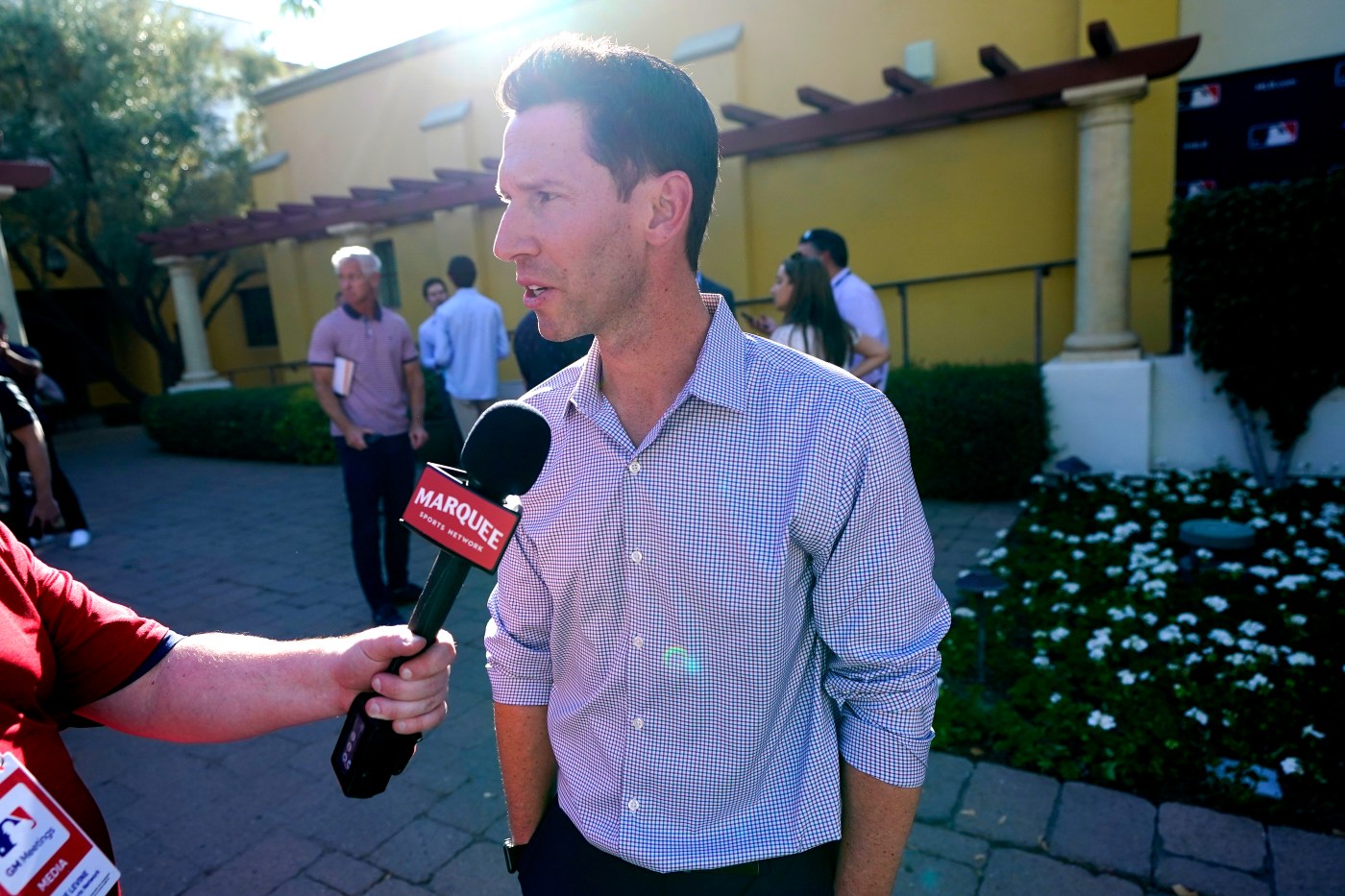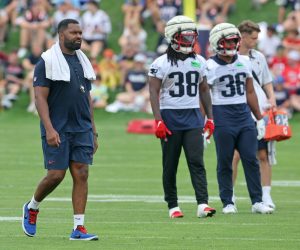
MLB Notes: Craig Breslow has Red Sox well positioned ahead of trade deadline
It’s been a long time since it felt like anything was possible for the Red Sox. For at least the last five years the club has been unable or unwilling to compete for the biggest names on the market, and for much of that stretch the club has pulled its punches in favor of building towards long-term success.
Could this be the week that finally changes?
The news that Alex Cora and the Red Sox had agreed to a three-year contract extension last Wednesday came like a bolt from the blue and was the strongest indicator yet that the club is ready to start pushing towards contention once again. Cora wouldn’t have agreed to the new deal without some level of assurance in the club’s near-term prospects, and chief baseball officer Craig Breslow has indicated on multiple occasions that the club plans to buy at the trade deadline.
Since then the Red Sox have already gone out and added a starting pitcher, and more moves could be on the way.
Armed with a big league roster that has significantly outperformed expectations, a loaded farm system and plenty of payroll flexibility, the Red Sox are well positioned to make a splash at the trade deadline. The table has been set for Breslow to go out and improve the team, and if he can follow through then the promise of October baseball in Boston may go from being a nice aspiration to an attainable and realistic goal.
What do the Sox need?
Pitching will be at the top of Boston’s shopping list, and the Red Sox wasted no time fortifying the starting rotation by re-acquiring left-hander James Paxton.
After spending the past two seasons in Boston and posting a 4.50 ERA over 96 innings last season, Paxton signed with the Los Angeles Dodgers as a free agent this winter and made every start for his new club before the trade. Paxton posted a 4.43 ERA over 89.1 innings, and while his command hasn’t always been there, he’s largely answered his durability questions and threw one of his best games of the season last Sunday against the Red Sox.
He’ll now join a Red Sox rotation that also features an All-Star in Tanner Houck, a rock solid No. 2 in Kutter Crawford, two hot-and-cold mid-rotation options in Brayan Bello and Nick Pivetta, and a collection of stopgaps in the No. 5 spot that primarily includes Cooper Criswell and Josh Winckowski. Paxton also gives Boston a left-hander it can throw at opposing lineups while also shoring up the rotation’s floor.
Though the bullpen has generally been an area of strength, right now the group is heavily depleted and has blown a number of late leads since the All-Star break. Two of the club’s top three relievers, Chris Martin and Justin Slaten, are currently on the injured list, which has forced the others into less suitable roles. With so many huge series against other playoff contenders coming up, Boston can’t wait for everyone to get healthy, so bringing in at least one more high-leverage arm is a must.
The offense isn’t as urgent a concern, but the club’s struggles against left-handed pitching have been pronounced. Another right-handed bat to help balance the lineup and provide additional depth could go a long way towards addressing that issue, and getting an established middle infielder to fortify the second base spot would be an added bonus.
Who are top players on the market?
If the Red Sox wanted to make a splash, the biggest statement they could make would be going out and trading for Chicago White Sox ace Garrett Crochet or Detroit Tigers ace Tarik Skubal, who as of this writing are both still available. Both lefties are Cy Young candidates with multiple remaining years of team control who could immediately slot in with Houck as front-of-the-rotation anchors, and their arrival would signal a new era of competitiveness for a Red Sox franchise that has recently been content to play the long game.
They would also cost at least two of Marcelo Mayer, Roman Anthony and Kyle Teel — if not all three — which is probably not a price the Red Sox are comfortable paying.
The Red Sox probably don’t need any more starters after acquiring Paxton, but if they wanted to shake things up there are still plenty of others who could move the needle. Among those who hadn’t been moved as of Saturday afternoon, Detroit’s Jack Flaherty and White Sox righty Erick Fedde are two appealing candidates, as are Chicago Cubs righty Jameson Taillon, Toronto’s Yusei Kikuchi and Cincinnati’s Frankie Montas.
On the bullpen front, the two big names are Oakland’s Mason Miller and Miami’s Tanner Scott. Both were All-Stars who have posted dominant numbers for their respective last-place teams, and Miller in particular is a phenom who put on a show at Fenway Park earlier this month with his 101-104 mph heater and filthy stuff, though he also just went on the IL with a broken pinky in his non-throwing hand.
For Boston, who needs high-leverage reinforcements but not necessarily a closer, Detroit’s Andrew Chafin and Drew Smyly of the Cubs would be obvious targets. Both are veteran left-handers who are enjoying strong seasons for their respective clubs, and if he didn’t mind shifting to a set-up role Angels closer Carlos Estevez would provide a huge boost as well.
As for what kind of bats the Red Sox could add, the most popular name bandied about by far is Angels infielder Luis Rengifo, who is a switch-hitting super utility standout currently batting over .300 with 20-plus stolen bases. He checks every box and could both slot in as the starting second baseman this season and serve as a Brock Holt type going forward, allowing guys like Vaughn Grissom and Mayer to move up without blocking their paths.
White Sox shortstop Paul DeJong is another infielder who could work as a second-half rental.
Other names to watch at the trade deadline who don’t make as much sense for Boston include White Sox outfielder Luis Robert Jr., Oakland slugger Brent Rooker, Miami second baseman and outfielder Jazz Chisholm Jr. and Cubs outfielder Cody Bellinger. Tampa Bay also just traded outfielder Randy Arozarena to Seattle and starter Zach Eflin within the division to Baltimore.
Which big leaguers could Sox trade?
Should the Red Sox swing a deal, who could they conceivably give up in return? The club has two talent pools from which it can draw: the major league roster and its collection of prospects.
If the club plans to buy at the deadline then trading from the big league club wouldn’t be ideal, but there are several obvious candidates who’d be most likely to go.
The most likely trade candidate is Kenley Jansen, who would be highly coveted by other contenders and who is unlikely to remain in Boston past this season. The Red Sox also have a potential replacement already on the roster in Liam Hendriks, but given how shorthanded the bullpen is and the urgent need for frontline help, taking Jansen out of the equation now would be counterproductive, even if the move was paired with another trade for a top reliever.
Boston’s other pending free agents offer similar drawbacks. Tyler O’Neill and Nick Pivetta may not remain with the Red Sox past this season and the club has long-term alternatives waiting in the wings, but Boston also isn’t in a position to be unloading impactful right-handed bats or established starting pitchers if it expects to compete.
Though much more of a long-shot, the player who it would make most sense for the Red Sox to trade is arguably Masataka Yoshida.
With the way Boston’s roster is structured, Yoshida isn’t a good fit for the Red Sox anymore. He’s no longer a factor in the outfield and has become consigned to full-time designated hitter duty, and whenever the club needs to give someone else like Rafael Devers or O’Neill a day off their feet, Yoshida winds up being relegated to the bench. That’s not what you want from a guy who is in the second year of a five-year, $90 million contract, so moving Yoshida would free up both roster and payroll flexibility and allow Boston the freedom to bring in someone else who better complements the club.
It should be noted that while Yoshida has been disappointing, he hasn’t necessarily been bad. He’s been an above average hitter ever since he came over from Japan, and while he’s been hampered by injuries this season, he’s also begun heating up recently and is batting .310 with an .842 OPS for the month of July. If there’s a club out there that needs a left-handed bat and maybe doesn’t have as much outfield depth as Boston, Yoshida could make sense.
Like I said, it’s a long shot, but that’s a move Boston could make that would help the club reach its long-term goals without significantly hampering its playoff odds this season.
Prospects on trade watch?
How about Boston’s prospects? Over the last five years the organization has amassed an impressive collection of young talent, which tilts heavily towards position players and infielders in particular.
Much of that talent is now bubbling up towards the upper minors, and it’s getting to the point where the Red Sox are going to have to start making decisions on who to keep and who to move.
Boston’s “big three” of Mayer, Anthony and Teel are unlikely to be dealt, but other prospects like Nick Yorke, Kristian Campbell, Enmanuel Valdez, Chase Meidroth, Matthew Lugo and Blaze Jordan could all potentially be on the table. All of those players are infielders, and right now the Red Sox are having a hard enough time finding each of them playing time in Worcester and Portland as it is. That will only become more challenging when the Red Sox eventually promote Mayer to Triple-A.
While the Red Sox have much less pitching depth by comparison, the club’s recent acquisition of 14 new arms in the draft could help make some of its more established prospects expendable.
Devin Pearson, the club’s director of amateur scouting, said as much following the draft.
“It’s important, not only for the system in terms of having some pitchers we’re excited about but also from the acquisition side, just having some flexibility on trades and things like that,” Pearson said.
With Luis Perales on the shelf for the foreseeable future after undergoing Tommy John surgery, Boston’s top pitching prospects are currently Wikelman Gonzalez and Richard Fitts. David Sandlin — acquired in the John Schreiber deal earlier this spring — is also on the rise and was recently promoted to Double-A. Relievers Ryan Zeferjahn and Luis Guerrero, both of whom can hit 100 mph on the radar gun, could also draw interest as plug-and-play bullpen options.
The last factor Boston needs to consider is the Rule 5 Draft. According to SoxProspects.com the Red Sox have 58 prospects who will become Rule 5 eligible this offseason, meaning they’d have to be added to the 40-man roster or risk being lost to another club. That list includes Yorke, Jordan, Lugo, Fitts, Zeferjahn, Guerrero and a whole bunch of others.
There’s no way the Red Sox will be able to keep everyone, so the best thing they can do is make some decisions now and try to use their excess prospect capital to bolster the big league roster.
That was the whole point of building up the farm system, right? To help set the Red Sox up for sustainable success. Well after going through a lot of hardship the Red Sox finally have a bountiful crop of young talent, and with a playoff berth now within reach, the time for a harvest is here at last.


